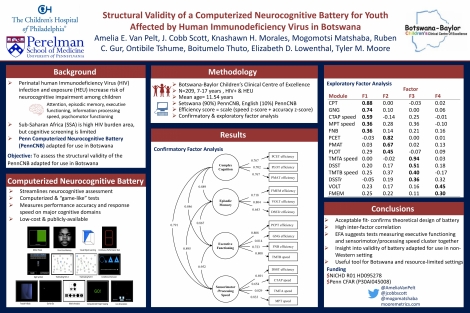Amelia Van Pelt
Structural Validity of a Computerized Neurocognitive Battery for Youth Affected by Human Immunodeficiency Virus in Botswana
Abstract
Introduction: Human Immunodeficiency Virus (HIV) infection and in utero HIV exposure are associated with increased risk of pediatric neurocognitive impairment. In Sub-Saharan Africa, in utero HIV exposures and infection are common, but standardized cognitive screening is limited. To address the lack of available neurocognitive screening, the Penn Computerized Neurocognitive Battery (PennCNB), a tool that streamlines evaluation of neurocognitive functioning, was culturally adapted for use among youth in Botswana. The current sub-study examined the structural validity of the culturally-adapted PennCNB.
Methodology: A cohort of 7-17 year old children living with HIV (HIV+) and HIV-exposed-uninfected (HEU) children were enrolled from the Botswana-Baylor Children’s Clinical Centre of Excellence in Gaborone, Botswana. Confirmatory and exploratory factor analyses were performed on speed, accuracy, and efficiency measures for 13 PennCNB tests.
Results: Fit of the confirmatory factor analysis was acceptable, which supports the design of the battery measuring four neurocognitive domains: executive functioning, episodic memory, complex cognition, and sensorimotor/processing speed. The model revealed high inter-factor correlation. Exploratory factor analysis suggested that tests assessing executive functioning and sensorimotor/processing speed clustered together rather than forming distinct factors, which is consistent for this age group.
Conclusions: These findings provide valuable insight into the structural validity of a computerized neurocognitive battery adapted for use in Botswana, suggesting that the PennCNB could serve as a useful tool for the assessment of neurocognitive function in a non-Western setting such as Sub-Saharan Africa, thus providing advantages for implementation, such as automated scoring and data generation, increased standardization and reliability, and ease of administration.
Keywords
neurocognitive assessment, structural validity, youth, HIV, AfricaCommenting is now closed.
About Us
To understand health and disease today, we need new thinking and novel science —the kind we create when multiple disciplines work together from the ground up. That is why this department has put forward a bold vision in population-health science: a single academic home for biostatistics, epidemiology and informatics.
© 2023 Trustees of the University of Pennsylvania. All rights reserved.. | Disclaimer




Comments